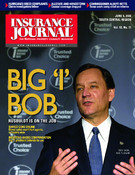The last 24 months have been traumatic for the insurance industry, but the profit picture for 2006 is good overall, Robert P. Hartwig, Insurance Information Institute senior vice president and chief economist, said during the recent National Council on Com-pensation Insurance Annual Issues Symposium in Orlando, Fla.
“Recapping last year vs. 2004, if there is one downside to what has happened recently it is that we have entered a period in which premium growth is basically grinding almost to a halt,” Hart-wig told more than 700 workers’ compensation executives attending the symposium. He said 2005 premium growth slowed to about one-half of 1 percent, the slowest since the 1990s. In addition, losses crept higher. As a result, “we are going to expect to see some deterioration in underwriting industry-wide in the year ahead,” he said. “Nevertheless, we started from a relatively strong starting point, outside catastrophe-prone lines. The in-dustry experienced a small un-derwriting loss last year, after 2004’s first underwriting gain since 1978. Investment income is up considerably, while net in-come is up about 12 percent. That is a very large leap considering we had record catastrophe losses.”
Hartwig said he was sure the audience must be wondering, “How is it that these results ended up being so good, despite record catastrophe losses?”
Resiliency a key strength
Looking at the profit picture, Hartwig quoted statistics indicating the industry generated about $43 billion in profits last year.
“That may sound like a lot, it may sound like a record—it is a record in nominal profit terms,” Hartwig said. “However it is not a record when it comes to ROE, which was 10.5 percent.
“In fact, we weren’t even remotely close to profitability levels the industry experienced at peak points of the cycles in the 1970s and 1980s, which were close to 20 percent,” he said.
Weak premium picture
He predicted “a period where we are going to rebound from very sluggish premium growth in 2005 to something in the 3 to 4 percent range in aggregate in 2006, and then reduced growth will be encountered after that.
“On an inflation-adjusted basis, premium growth in 2006 is going to be effectively zero, or even slightly negative for the next several years,” Hartwig said.
He added that the current period is very much like what happened after 1992, when there was a boost in premium income and then it fell off. He suggested something similar would occur over the next several years.
Can underwriting margins be maintained?
“The question is, ‘Can the industry maintain its underwriting margins in this era of sluggish premium growth outside of property coverages?'” Hartwig asked.
He said over the past several years storms have had a dramatic impact on industry profitability, despite the fact that it had a “record profit in nominal dollar terms” of 10.5 percent last year. But “10.5 percent just does not cut it across the industry,” Hartwig explained. “When you look at the sorts of risks insurers are being asked to assume, it is a tremendous risk. Considering you can get more than 5 percent today on a risk-free investment, is 10.5 percent the kind of return you should expect when you are assuming catastrophic hurricane risk, terrorism risk or any other sort of catastrophic risk? The answer is, probably not!”
Hartwig said the storms over the past few years knocked 4 to 5 points off the industry’s returns over the past two years.
“It’s very, very fortunate that the industry entered the 2004 and 2005 hurricane seasons in a position of extraordinary financial strength,” Hartwig explained.
He said in terms of the major coverages, over the past decade the average return for all property/casualty lines is 7.7 percent, and for workers’ comp it is 7.9 percent.
Was this article valuable?
Here are more articles you may enjoy.


 Consumer Acceptance of Telematics Widens, Says Survey
Consumer Acceptance of Telematics Widens, Says Survey  DoorDash, Uber Cost Drivers $550 Million in Tips, NYC Says
DoorDash, Uber Cost Drivers $550 Million in Tips, NYC Says  LA Fire Survivors Got a Rude Surprise That Could Hit More Americans
LA Fire Survivors Got a Rude Surprise That Could Hit More Americans  Florida Lawmakers Ready for Another Shot at Litigation Funding Limits
Florida Lawmakers Ready for Another Shot at Litigation Funding Limits 


